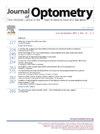Prevalence of astigmatism among 99,515 children in different areas of Xi'an City, China
IF 1.8
Q2 OPHTHALMOLOGY
引用次数: 0
Abstract
Purpose
To investigate the prevalence of astigmatism among children in different areas of Xi'an.
Methods
A cross-sectional study was conducted in Xi'an, China, involving children from 139 primary schools, 28 junior high schools, and 10 senior high schools. Data on uncorrected visual acuity (UCVA) and non-cycloplegic spherical equivalent (SE) were collected from March 2023 to June 2023 based on a new screening model by the Department of Ophthalmology of Xi'an Central Hospital. Data from the right eye were included in the statistical analysis. Trend changes in astigmatism prevalence across different areas, educational stages, ages, and genders were analyzed using the X² test and trend test.
Results
A total of 99,515 children were included in the analysis. The overall prevalence of astigmatism was 59.3% [95% CI: 59.0% to 59.6%]. The prevalence of astigmatism was higher in urban areas compared to the urban-rural fringe (61.1% [95% CI: 60.6% to 61.6%] vs. 58.3% [95% CI: 57.9% to 58.7%]) (X²trend = 73.174, P < 0.05). Boys had a higher prevalence of astigmatism than girls (59.8% [95% CI: 59.4% to 60.2%] vs. 58.8% [95% CI: 58.6% to 59.0%]) (X²trend = 11.613, P < 0.05). Compared to the primary and senior school, the overall prevalence of astigmatism is most significant during the junior school stage (X²trend = 1710.133, P < 0.05), with rates of 54.6% in primary school, 71.3% in junior high school, and 68.7% in senior high school (X²trend = 10.694–868.913, P < 0.05), among which grade 9 has the highest prevalence (X²trend = 2766.194, P < 0.05). Myopia severity increased with the degree of astigmatism (X²trend = 2547.677, P < 0.05), and boys were more likely to experience worsening myopia with increasing astigmatism compared to girls (X²trend = 36.878, P < 0.05).
Conclusions
Astigmatism was most prevalent among children in Xi'an during junior school, peaking in grade 9. Urban areas showed higher incidence rates than urban-rural ones, and boys had a consistently higher prevalence than girls, with WTR being the most common type.
西安市不同地区99515名儿童散光患病率调查
目的了解西安市不同地区儿童散光情况。方法对西安市139所小学、28所初中和10所高中的儿童进行横断面研究。2023年3月至2023年6月,采用西安市中心医院眼科新筛查模型,采集患者未矫正视力(UCVA)和非睫状体麻痹球等效视力(SE)数据。右眼数据纳入统计分析。采用X²检验和趋势检验分析散光患病率在不同地区、教育阶段、年龄和性别之间的趋势变化。结果共纳入99,515名儿童。散光的总患病率为59.3% [95% CI: 59.0% ~ 59.6%]。城市散光患病率高于城乡结合部(61.1% [95% CI: 60.6% ~ 61.6%] vs. 58.3% [95% CI: 57.9% ~ 58.7%]) (X²趋势= 73.174,P <;0.05)。男孩散光患病率高于女孩(59.8% [95% CI: 59.4% ~ 60.2%]比58.8% [95% CI: 58.6% ~ 59.0%]) (X²趋势= 11.613,P <;0.05)。与小学和高中阶段相比,初中阶段散光总体患病率最高(X²趋势= 1710.133,P <;0.05),其中小学为54.6%,初中为71.3%,高中为68.7% (X²趋势= 10.694-868.913,P <;0.05),其中9年级患病率最高(X²趋势= 2766.194,P <;0.05)。近视严重程度随散光程度的增加而增加(X²趋势= 2547.677,P <;0.05),且男孩比女孩更容易随着散光的增加而加重近视(X²趋势= 36.878,P <;0.05)。结论西安市儿童污名化在初中阶段最为普遍,在九年级达到高峰。城市地区的发病率高于城乡地区,男孩的患病率始终高于女孩,其中WTR是最常见的类型。
本文章由计算机程序翻译,如有差异,请以英文原文为准。
求助全文
约1分钟内获得全文
求助全文

 求助内容:
求助内容: 应助结果提醒方式:
应助结果提醒方式:


